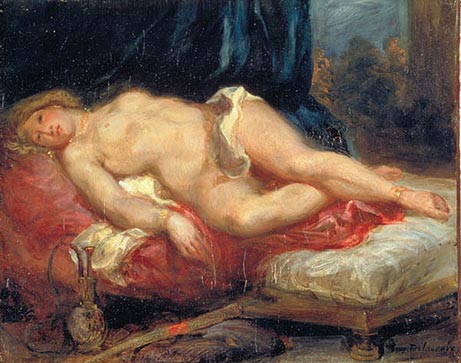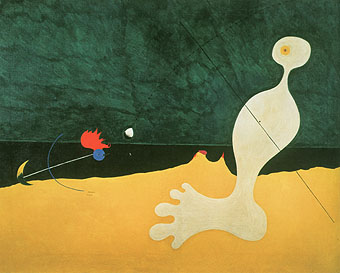To: Republicanprofessor
Once again, thank you. Could you perhaps give us all a succinct definition of the various styles followed by the more well known artists that followed that particular form? For example, define for us "realism," surrealism," "abstract," "Hudson River," "wacko-jacko," etc.
To: Labyrinthos
Could you perhaps give us all a succinct definition of the various styles followed by the more well known artists that followed that particular form? For example, define for us "realism," surrealism," "abstract," "Hudson River,"Neoclassicism: a movement of the late 18th and early 19th century that had many of the values of classicism (so valued by many FReepers). This art developed from that of Poussin (see above) and had strong drawing and little emotion. This included David and Ingres.

David Death of Socrates 1787 or so
Romanticism: a movement that reacted against the stiffer, more controlled Neoclassicism. The Romantics were interested in extreme emotions and subjective views. They valued color over drawing and extreme subjects of life and death. They included Turner, Gerricault, Delacroix, Gros and many others. Notice how much more emotional and dynamic their work is than the classicists above.

J.M.W. Turner Slave Ship 1835
My favorite Neoclassicist/Romantic contrast is that of the Odalisques by Ingres (left) and Delacroix (right). An odalisque is a woman of a middle eastern harem. Note the funny apparatus in the lower corners: these ladies smoked something funny. The connection between drugs and use of women for sexual purposes is long established. What is the “story” in each of these? Before or after their encounters? And what kind of an encounter was it?


Realism (with a capital R) was a mid-19th century movement that I dealt with in my first "class" 2 weeks ago. These artists moved away from the overwrought emotion of the Romantics (such as Turner) and painted real subjects in a real world. These included Courbet and Manet in France and Homer and Eakins in the U.S. See “class” #1 two weeks ago for more details. Often their work is darker than the subsequent Impressionists.


realism with a little “r” is a general and vague term for works that look as if you were looking at them at the moment or with almost photographic precision.
Naturalism can be a synonym for realism, but it also refers to works that look realistic but could not be happening. As in the mythological Apollo and Daphne by Bernini in the 17th century.

Representational art is another synonym for realism. It’s what we could see in reality.
Surrealism is a movement beginning about 1925 with a manifesto by Andre Breton that emphasized the importance of dreams in our lives (and in our art). These artists are reacting against the carnage of WWI that came about as a result of the rational world. There are two kinds of surrealism (we’ll get to this about lecture 5): 1) the magic surrealism of Dali, Magritte and others and the 2) Biormorphic Surrealism of Miro and Masson.


Dali Persistence of Memory (known more colloquially as the melting clocks) and Miro's Person Throwing a Stone at a Bird
That’s about all the definitions I can handle right now. Hope that helps; it’s a beginning.
To: Labyrinthos
Oops. Forgot a couple of important definitions you asked for.
Hudson River School artists were the first really important “school” of artists in the U.S. A school is just a group of artists painting in a similar way (not in a little school house). These artists, including Cole, Church, Bierstadt, Durand and many others, emphasized the beauty of our landscape (vs. the “history” and mythology paintings of Europe) and gave our land a spiritual quality similar to the religious paintings of Europe.


Thomas Cole Expulsion from Eden about 1840 and Albert Bierstadt Yosemite Valley about 1860 or so.
Abstraction is taking any image a step or two away from "reality" by emphasizing something the artist wants to deal with: super bright colors, distorted forms, etc. Sometimes it is mistaken with non-objective art, which has no basis in reality at all.


abstraction by Georgia O’Keeffe Jack in the Pulpit IV and non-objective art by Mondrian both about 1920-30
To: Labyrinthos
You might want to get a basic art appreciation or survey of art text. Then you can soak up all the info you seem to be eager for. You may find one at your local library or used book store. I prefer a chronological view of art history, because then you can place the works and artists in the development of history. Some Art Ap books are touchy-feely: here's some watercolor, here's some sculpture, and it's all out of historical context. I hate those books.
Some titles that could be useful:
Janson's History of Art, a staple for decades. or his History of Art for Young People
Stokstad's and Gardner's History of Art books aren't bad, but they have more history in them and one could get bogged down. (Of course, you can skim and read what you want.)
Wilkins and Schultz's Art Past, Art Present is what I often use for class, but they split up artists and periods too much in order to keep it so strictly chronological. Michaelangelo is in 4 different sections! And it had a ton of non-western art, interspersed with western art; too much for me to handle in class. But the descriptions of the artworks are concise and the examples chosen are good.
FreeRepublic.com is powered by software copyright 2000-2008 John Robinson











